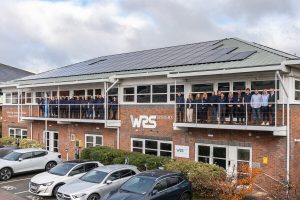Sustainability is an objective that’s high on everyone’s agenda. In every nation, we all have a responsibility and role to play in building a more sustainable future.
Cities have a disproportionate impact on the environment, and therefore have a greater role to play in meeting sustainability objectives. We have for a long time seen an increasing trend in urbanisation and this brings challenges in the work towards sustainability.
An important framework for cities has been provided by the United Nations Sustainable Development Goals (SDGs). Created in 2015 and designed to be achieved by 2030, the SDGs are 17 interlinked global goals designed to be a “blueprint to achieve a better and more sustainable future for all”.
The SDGs cover many areas – while Goal 11 is specifically focused on making “cities and human settlements inclusive, safe, resilient and sustainable”, there are aspects of many of the other goals which also have relevance to urban centres.
From video surveillance to actionable data
The link between technology, data and sustainability is clear, and the adoption of the SDGs by the world’s cities is in no doubt. Recent research by ESI ThoughtLab, which surveyed administrators in 167 cities around the world, found how effective use of technology and data is seen as foundational to achieving the SDGs. The research found that the cities making best progress towards the SDGs were also leaders in using technology, data and partnerships to achieve their social, environmental and economic goals.
Sustainability has always been a priority for Axis’s own business, but of course we also want to support our customers in achieving their own sustainability goals. As video surveillance technology has been transformed, we’re in a better position to do so today than ever before.
Our solutions can keep an eye on challenges such as air quality, energy consumption and extreme weather, as well as traffic flow and the evolving needs of public safety and citizens’ ability to move around freely and easily. The increasing sophistication of video surveillance technology – particularly related to video analytics and the ability to link data from sensors of multiple types, including video cameras – means that it can support a number of the challenges facing cities, specifically the SDGs smart cities are looking to accomplish.
Three of the fundamental areas that cities are focused on and which directly relate to a number of SDGs are the environment, mobility and public safety. And far from being independent of each other, these factors are very much interlinked. Again, this reinforces the critical need to break down silos and enable data sharing across the city. As stated in SDG 17, partnerships are the main enabler of success in sustainability targets.
The environment as a measure of sustainability
Monitoring of environmental factors is essential in city sustainability and ensuring the health and wellbeing of citizens. Poor air quality and noise pollution are closely linked to serious health issues. Highly sensitive environmental sensors – such as those measuring air quality – used alongside video surveillance give city authorities early warning of issues, visual verification and the ability to take correct actions.
Video surveillance can also show that waste is being collected and managed in accordance with the SDGs, as well as monitoring for and deterring illegal dumping (including disposal of waste into the oceans, as covered by target 14.1), vandalism and even littering, all of which have a negative impact on a city’s environment.
The SDGs are, in part, a reaction to the environmental damage that has taken place over the industrial age – one result of which is, of course, climate change. The world is experiencing severe weather conditions on a more frequent basis, which has the potential to disrupt urban infrastructure, the provision of critical services and, with that, risk harm to citizens. Again, the SDGs focus specifically on this through target 11.5: “Reduce the adverse effects of natural disasters” with indicators related to the loss of human life and disruption to critical infrastructure.
Environmental and weather monitoring sensors give city authorities the time to prepare for severe weather; video surveillance can monitor both the weather conditions and movement of a city’s population; and connected technology such as audio can be used to relay live and prerecorded warnings and instructions to keep people safe. In the aftermath of natural disasters, video surveillance can also be of great help with rescue and relief operations.
Sustainable mobility and transportation
Enabling citizens to move around freely and easily is also a fundamental part of a city’s liveability, and is covered by target 11 in the SDGs. With the increasing number of people and vehicles in cities, it is critical that transportation and mobility has as minimal a negative impact on the environment as possible.
Video surveillance monitors traffic and how people move, detecting incidents which can cause traffic congestions – and therefore pollution. Within SDG 3, “Good Health and Well-Being”, a specific target relates to the reduction of road injuries and deaths. Again, video surveillance using traffic incident analytics is of huge benefit in the effective and safe management of urban traffic, whether public or private.
Increasingly, data from video surveillance cameras is being used as a proactive tool in planning and managing mobility infrastructure to reduce its environmental impact. Data from video surveillance can also be used to assist citizen mobility – for instance, directing drivers quickly and efficiently to available parking spots or electric vehicle recharging stations.
Public safety in cities
“Making people feel safe” is a goal for every city and is covered in part in the SDGs under target 11.7: “Provide access to safe and inclusive green and public spaces”. It’s also one of the fundamental roles that video surveillance plays across the whole city.
It remains a sad truth that the density of population in urban centres means that they are places that can both attract criminal activity and where incidents and emergencies can quickly become a serious risk to large numbers of people.
While these are perhaps seen as more “traditional” places for video surveillance, advances in technology mean that it is increasingly intelligent, accurate and allows for greater proactivity, rather than simply post-incident investigation.
Rather than rely purely on manual monitoring, intelligent video analytics can monitor multiple video streams, spotting anomalies, unusual patterns, specific objects or suspicious behaviour and quickly bring an operator’s attention to the scene. Intervention can then be triggered through emergency services, or via audio speakers on site, either warning criminals that they’re being watched, or offering assistance, advice and guidance to people at the scene.
Such rapid reaction can stop a crime before it committed, prevent the escalation of an incident, evacuate a specific area or provide direct assistance before emergency services arrive.
Prevention of specific crimes also directly supports other SDGs and targets. For instance, target 3.5 is focused on the prevention of drug and substance abuse, which can obviously be supported through the prevention of organised crime and drug dealing.
Continually exploring opportunities to support sustainability
This article contains just a few examples of where video surveillance and other sensors can directly support the achievement of the SDGs. But it isn’t just about how video surveillance is used to directly support the work towards SDGs in cities. Axis, together with our partners, offers flexible, scalable, and open-source camera and IoT solutions that contribute to make cities safer, more inclusive and more enjoyable to live in – and help them meet their sustainability goals at the same time.
Our high reputation and focus on social responsibility, integrity and the environment, together with our industry-leading cyber-security solutions, will increase both reputation and trust – and contribute to cities’ long-term resilience.
Learn more how Axis contributes to smarter, safer cities.




